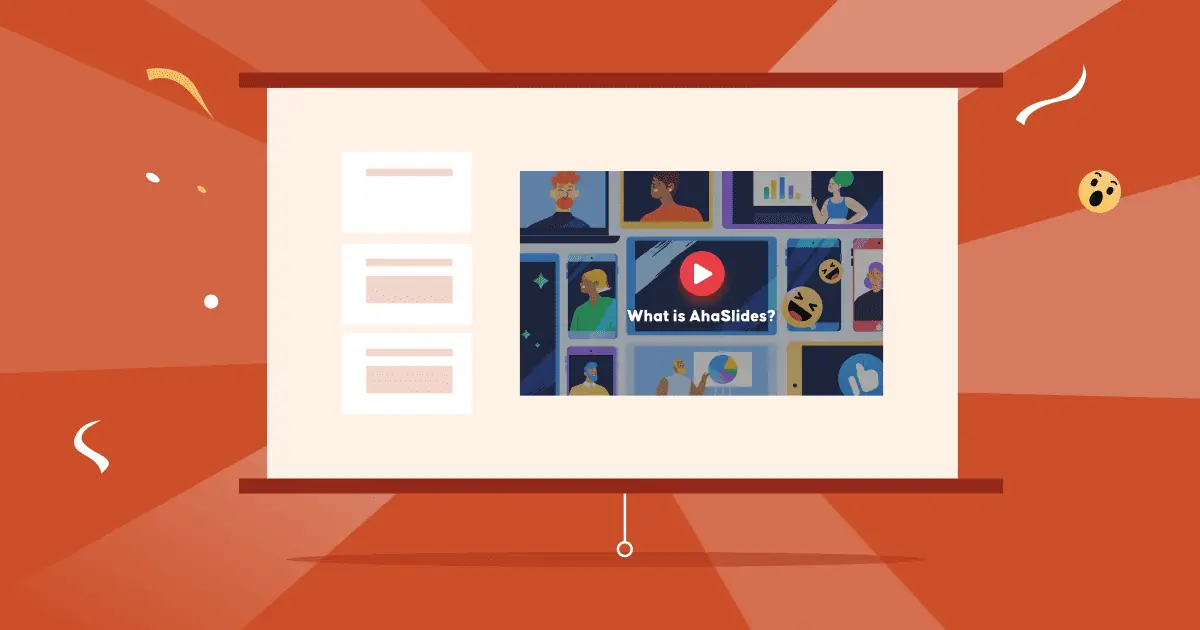Hoe debatteren voor beginners? Ruziemaken is een heel belangrijk onderwerp. Als je er nog nooit een hebt gedaan, kan het overweldigend zijn om te bedenken wat er gaat gebeuren en hoe je kunt voorkomen dat je er voor iedereen totaal onwetend uitziet.
Er valt nog veel te leren voordat je de moed kunt opbrengen om het podium op te gaan. Maar maak je geen zorgen; deze debatgids voor beginners geeft je de stappen, tips en voorbeelden die je nodig hebt om je volgende debat te winnen. Laten we dus eens kijken naar deze fantastische debattips!
Inhoudsopgave
- 7 stappen om een debat voor beginners op te zetten
- 10 tips voor nieuwe debaters
- 6 soorten debatten
- 2 debatvoorbeelden
- Meer tips met AhaSlides
Meer tips met AhaSlides

Begin binnen enkele seconden.
Ontvang gratis sjablonen voor studentendebatten. Meld u gratis aan en neem wat u wilt uit de sjabloonbibliotheek!
🚀 Ontvang gratis sjablonen ☁️
Hoe een debat voor beginners werkt (in 7 stappen)
Voordat je je argumenten als een pro formuleert, moet je weten hoe een beginnersdebat werkt. Bekijk deze 7 stappen voor een debat voor beginners en wat je daarbij moet doen. Dan zul je volledig begrijpen hoe je een betere debater wordt!
1. Het doel is bepaald

Omdat we debatten op veel plaatsen en in veel situaties kunnen gebruiken, zoals op scholen, bedrijfsvergaderingen, paneldiscussies of in politieke organen, is het cruciaal dat de primaire doelen van het debat eerst worden gekozen. Dit kan een duidelijk beeld geven van de planning en organisatie van de debatten, omdat er later veel details zijn om aan te werken, die allemaal op elkaar moeten worden afgestemd.
Dus, voordat er iets gebeurt, zal de facilitator deze vraag beantwoorden: wat zijn de doelen van dit debat??
Als u zich bijvoorbeeld in een student debatDe doelen moeten hetzelfde zijn als die van je les, bijvoorbeeld het stimuleren van het kritisch denkvermogen en de spreekvaardigheid van leerlingen. Op het werk kun je bijvoorbeeld kiezen welke van de twee ideeën je kiest.
2. De structuur is gekozen
Als je je afvraagt hoe je goed kunt debatteren, heb je een structuur nodig. Er zijn veel variaties op debatstructuren en verschillende formats daarbinnen. Het is belangrijk dat je eerst een aantal basistermen kent die in veel voorkomende debatten worden gebruikt, voordat je je op een debat voorbereidt...
- Thema – Elk debat heeft een onderwerp, dat formeel een debat wordt genoemd beweging or resolutieHet onderwerp kan een stelling, beleid of idee zijn, afhankelijk van de setting en het doel van het debat.
- Twee teams - Bevestigend (ondersteunt de motie) en Negatief (tegen de motie). In veel gevallen bestaat elk team uit drie leden.
- Jury or arbiters: De mensen die de kwaliteit van de argumenten beoordelen in het bewijs en de prestaties van de debaters.
- Tijdwaarnemer – De persoon die de tijd bijhoudt en de teams stopt als de tijd om is.
- Waarnemers – Er kunnen toeschouwers (publiek) bij het debat aanwezig zijn, maar zij mogen zich er niet mee bemoeien.
Voor een beginnersdebat hebben de teams na ontvangst van de motie tijd om zich voor te bereiden. De Bevestigend team begint het debat met hun eerste spreker, gevolgd door de eerste spreker van de Negatief team. Dan gaat het naar de tweede spreker in de Bevestigend team, terug naar de tweede spreker in de Negatief elftal, enzovoort.
Elke spreker komt aan het woord en presenteert zijn punten binnen de in het debatreglement vastgestelde tijd. Houd er rekening mee dat niet allen debatten eindigen met team Negatief; soms, team Bevestigend zal worden gevraagd om af te ronden.
Omdat je hier waarschijnlijk nieuw in bent, kun je het debatproces voor beginners hier vinden onderHet is gemakkelijk te volgen en kan in veel verschillende soorten debatten worden gebruikt.
3. Het debatplan is gemaakt
Om het debat soepel te laten verlopen, zal de gespreksleider een plan hebben dat: zo gedetailleerd mogelijkZe zouden je dit plan moeten laten weten, want dat helpt je om alles te visualiseren en voorkomt dat je van het pad afdwaalt. Dat is heel makkelijk te doen als je deelneemt aan een beginnersdebat.
Hieronder vindt u een eenvoudige checklist van wat een plan moet bevatten:
- Het doel van het debat
- De structuur
- Hoe de kamer wordt ingericht
- De tijdlijn en timing voor elke periode
- Formele debatregels en instructies voor de sprekers en juryleden
- Sjablonen voor het maken van aantekeningen voor de rollen
- De samenvatting om het debat af te sluiten wanneer het eindigt
4. De kamer is geregeld
De omgeving is van essentieel belang voor een debat, omdat deze de prestaties van de spreker in zekere mate kan beïnvloeden.
Je debat moet een zo professioneel mogelijke sfeer hebben. Er zijn veel manieren om een debatruimte in te richten, maar welke opstelling je ook kiest, alles draait om de 'sprekersruimte' in het midden. Dit is waar alle debatmagie ontstaat.
Elke spreker die de twee teams vertegenwoordigt, staat tijdens hun beurt in de luidsprekerruimte en keert terug naar hun stoel als ze klaar zijn.
Hieronder is een populair lay-outvoorbeeld voor een beginnersdebat:
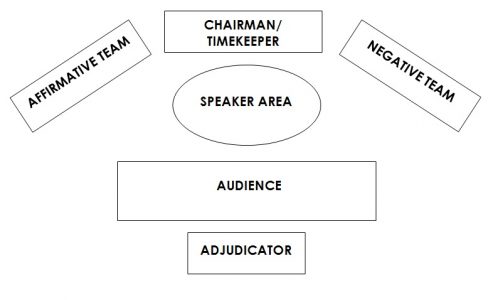
Natuurlijk is er altijd de mogelijkheid om online te debatteren. Het kan lastig zijn om dezelfde sfeer te ervaren als bij een online beginnersdebat, maar er zijn een paar manieren om het wat spannender te maken:
- Achtergrond maatwerk: Elke rol kan een andere Zoom-achtergrond hebben: de gastheer, tijdwaarnemer, juryleden en elk team. Dit kan helpen om de rollen van elke deelnemer te differentiëren en enige trots op de gegeven rol te inspireren.
- Ondersteunende apparaten:
- timer: Timing is belangrijk in een debat, vooral voor nieuwelingen bij hun eerste time-out. Je begeleider kan besluiten je tempo bij te houden met een timer op het scherm (hoewel in de meeste debatten de tijdwaarnemer alleen aangeeft wanneer er nog 1 minuut of 30 seconden over is).
- Geluidseffecten: Vergeet niet dat dit alleen een debat voor beginners is. U kunt van uw faciltator verwachten dat hij de sfeer verlicht met aanmoedigingen klappende geluidseffecten wanneer een spreker zijn toespraak beëindigt.
5. De teams worden gekozen
De teams worden verdeeld in: Bevestigend en Negatief. Gewoonlijk zijn de teams en de sprekersposities binnen die teams willekeurig, dus uw begeleider kan een spinner wiel om het proces spannender en boeiender te maken.
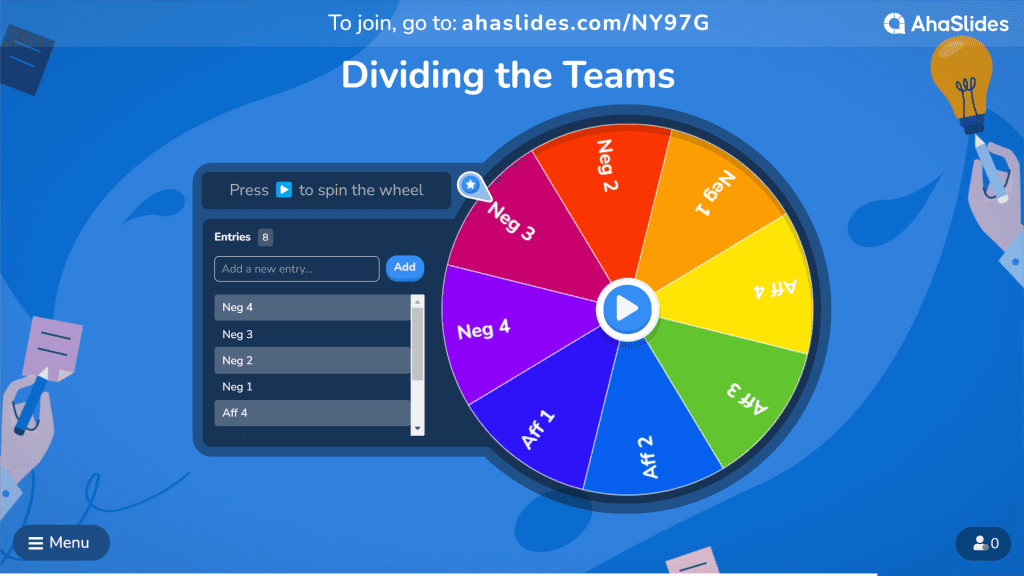
Nadat de twee teams zijn gekozen, wordt de motie bekendgemaakt en krijgt u de tijd om zich voor te bereiden. Idealiter krijgt u een uur de tijd.
In deze tijd zal de begeleider veel verschillende bronnen aanwijzen, zodat teams de context en de problemen kunnen begrijpen om sterkere punten te maken. Hoe meer je weet, hoe heftiger het debat.
6. Het debat begint
Elk ander type debat vereist een ander format, en er kunnen veel variaties zijn. Hieronder vindt u een zeer populaire versie die in elk debat voor beginners kan worden gebruikt.
Elk team krijgt vier keer de kans om te spreken in dit debat, dus het is het beste om 6 of 8 sprekers te hebben. In het geval van 6 spreken twee debaters twee keer.
| Spraak | Tijd | Verantwoordelijkheden van de debaters |
| 1e Bevestigend Constructief | 8 min | Introduceer de beweging en hun standpunt Geef hun definities van de belangrijkste termen Presenteer hun argumenten om de motie te ondersteunen |
| 1e Negatief Constructief | 8 min | Noem hun argumenten om zich tegen de motie te verzetten |
| 2e Bevestigend Constructief | 8 min | Geef verdere argumenten ter ondersteuning van de motie en de standpunten van het team. Identificeer conflictgebieden Beantwoord vragen van de negatieve spreker (indien aanwezig) |
| 2e Negatief Constructief | 8 min | Geef verdere argumenten tegen de motie en versterk de mening van het team. Identificeer conflictgebieden Beantwoord vragen van de bevestigende spreker (indien aanwezig) |
| 1e negatieve weerlegging | 4 min | Verdedig de Negatief argumenten van het team en de ondersteunende argumenten verwerpen zonder nieuwe argumenten of informatie toe te voegen |
| 1e bevestigend weerwoord | 4 min | Verdedig de Bevestigend argumenten van het team en versla de tegenovergestelde argumenten zonder nieuwe argumenten of informatie toe te voegen |
| 2e negatieve weerlegging (Conclusie) | 4 min | Heb een tweede weerwoord en slotverklaringen |
| 2e bevestigende weerlegging (Conclusie) | 4 min | Heb een tweede weerwoord en slotverklaringen |
👏 Afhankelijk van de regels kan er een korte voorbereidingstijd zijn voordat de weerleggingen plaatsvinden.
U kunt een videovoorbeeld van dit formaat zien Hieronder.
7. Beoordeel het debat
Het is tijd voor de juryleden om aan de slag te gaan. Ze moeten de debatten en de prestaties van elke debater observeren en vervolgens beoordelen. Dit zijn enkele aspecten waar ze op zullen letten bij jouw prestaties...
- Organisatie en duidelijkheid – De structuur van je toespraak – is het zinvol om deze op deze manier op te stellen?
- Beschrijving – De argumenten, het bewijsmateriaal, het kruisverhoor en de weerleggingen die u aanvoert.
- Levering en presentatiestijl – Hoe u uw punten overbrengt, inclusief gesproken taal, lichaamstaal, ooginhoud en de gebruikte toon.
10 tips voor nieuwe debaters
Niemand kan alles vanaf het begin beheersen en als je nog nooit in je leven hebt gedebatteerd, is het niet makkelijk om ermee te beginnen. Hieronder staan 10 snelle tips om te ontdekken hoe je effectief kunt debatteren en in elk debat met de nieuwelingen mee kunt gaan.
#1 - Voorbereiding is de sleutel – Onderzoek het onderwerp veel geld vooraf om niet alleen achtergrondinformatie, maar ook vertrouwen te krijgen. Dit kan beginnende debaters helpen de kwesties beter te begrijpen, zodat ze goede weerleggingsstarters kunnen zijn, vervolgens hun argumenten kunnen opstellen, bewijs kunnen vinden en kunnen voorkomen dat ze in een konijnenhol terechtkomen. Elke debater zou alles in punten moeten schetsen (idealiter 3 punten voor 3 argumenten) om ideeën beter te ordenen en het 'grote plaatje' van hun toespraak te zien.
#2 - Houd alles bij het onderwerp – Een van de zonden van debatteren is dat je van de rails raakt, omdat het kostbare spreektijd verspilt en het argument verzwakt. Let op de hoofdlijnen en hoofdpunten om ervoor te zorgen dat ze het onderwerp volgen en de juiste problemen aanpakken.
#3 - Maak uw punten met voorbeelden – Door voorbeelden te gebruiken worden uw debatzinnen overtuigender en zien mensen de zaken ook duidelijker, zoals dit voorbeeld hieronder…
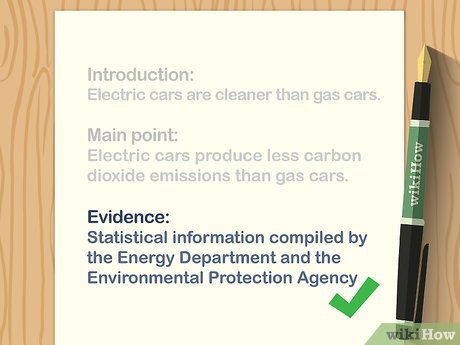
#4 - Probeer te denken zoals de tegenstanders – Denk tijdens het herzien van ideeën na over mogelijke punten die de tegenpartij zou kunnen aanvoeren. Identificeer er een paar en maak een mindmap van weerleggingen die je zou kunnen aanvoeren als ze niet kloppen. do eindigen met het maken van die punten.
#5 - Heb een sterke conclusie – Beëindig het debat met een paar goede zinnen, die in ieder geval de belangrijkste punten kunnen samenvatten. Vaak sluiten debaters graag krachtig af, met één poëtisch geformuleerde zin om dat te bewerkstelligen. mic druppel even (bekijk een voorbeeld hiervan hieronder).
#6 - Wees zelfverzekerd (of doe alsof totdat je het haalt!) – Een van de belangrijkste aspecten van beter debatteren is de sfeer. Debaters moeten zelfverzekerd zijn over wat ze zeggen, want bravoure heeft een grote invloed op juryleden en toeschouwers. Natuurlijk, hoe beter je je voorbereidt, hoe zelfverzekerder je bent.
#7 - Praat langzaam – Een veelvoorkomend probleem met beginnende debaters is hun spreeksnelheid. Vaak is het de eerste keer veel te snel, wat zowel de luisteraars als de spreker angstig maakt. Haal adem en spreek langzaam. Je krijgt misschien minder te horen, maar wat je produceert, zal overtuigend zijn.
#8 - Gebruik je lichaam en gezicht Lichaamstaal kan je standpunten ondersteunen en zelfvertrouwen uitstralen. Kijk de tegenstanders in de ogen, neem een nette houding aan en beheers je gezichtsuitdrukkingen (word niet te agressief) om de aandacht te trekken.
#9 - Luister goed en maak aantekeningen – Debaters moeten aandacht besteden aan elke speech en elk idee om het tempo te volgen, hun teamgenoten te ondersteunen en de tegenstanders beter te weerleggen. Aantekeningen kunnen hierbij helpen, aangezien niemand elk punt kan onthouden om te weerleggen of verder uit te diepen. Vergeet niet om alleen de belangrijkste punten te noteren.
#10 - Vermijd goedkope shots – Concentreer je op de argumenten van je tegenstanders en weerleg ze, niet op de tegenstanders zelf. Geen enkele debater mag anderen beledigen; dat getuigt van een gebrek aan professionaliteit en je krijgt er zeker een punt voor.
6 stijlen van beginnersdebatten
Er zijn veel debatstijlen met verschillende formats en regels. Als beginnende debaters een aantal daarvan goed kennen, kunnen ze beter zien wat het proces is en wat ze moeten doen. Hier zijn enkele veelvoorkomende debatstijlen die u mogelijk tegenkomt tijdens uw eerste debat!
1. beleidsdebat – Dit is een veelvoorkomend type dat veel onderzoek vereist. De discussie draait om de vraag of een bepaald beleid al dan niet moet worden ingevoerd, en meestal in de vorm van een team van twee of meer mensen. beleidsdebat wordt in veel scholen gebruikt omdat het praktisch is en de regels gemakkelijker te volgen zijn dan andere typen.
2. parlementair debat – Deze debatstijl is gebaseerd op het Britse regeringsmodel en de debatten in het Britse parlement. Oorspronkelijk overgenomen door Britse universiteiten, is dit nu de officiële debatstijl van veel grote debatwedstrijden zoals het World University Debating Championship en het European Universities Debating Championship. Dergelijke debatten zijn geestig en korter dan de traditionele. beleidsmaatregelen debat, waardoor het geschikt is voor veel gevallen, van middelbare scholen tot universiteiten.
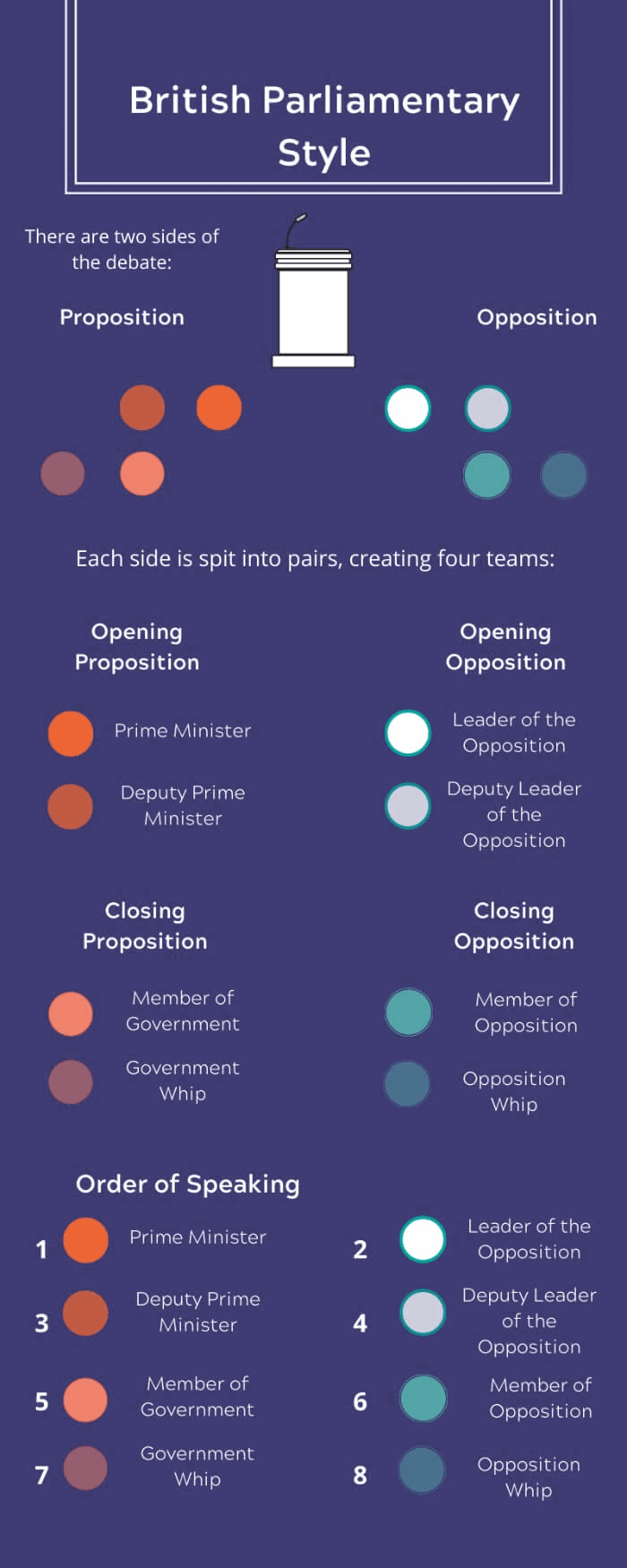
3. Publiek forumdebat – In deze stijl debatteren twee teams over een aantal 'hete' en controversiële onderwerpen of actuele gebeurtenissen. Over deze onderwerpen heb je waarschijnlijk al een mening, dus dit type debat is toegankelijker dan een beleidsmaatregelen debat.
4. Lincoln Douglas debat– Dit is een open, één-op-één debatstijl, vernoemd naar een beroemde reeks debatten in 1858 tussen de Amerikaanse Senaatskandidaten Abraham Lincoln en Stephen Douglas. In deze stijl richten debaters zich op diepgaandere of meer filosofische vragen, voornamelijk over belangrijke kwesties.
5. Spontaan redenering – Twee debaters debatteren over één specifiek onderwerp; ze moeten hun argumenten in zeer korte tijd formuleren en snel reageren op de ideeën van hun tegenstanders, zonder veel voorbereiding. Dit vereist sterke argumentatieve vaardigheden en kan helpen het zelfvertrouwen te vergroten en podiumangst te overwinnen.
6. Congressional debat – Deze stijl is een simulatie van de Amerikaanse wetgevende macht, waarbij de debaters Congresleden imiteren. Ze debatteren over wetgeving, waaronder wetsvoorstellen (wetsvoorstellen) en resoluties (standpunten). Het fictieve Congres stemt vervolgens over de goedkeuring van de wet en blijft voor of tegen de wetgeving stemmen.
2 debatvoorbeelden
Hier volgen twee voorbeelden van debatten, zodat u beter kunt zien hoe ze plaatsvinden…
1. Brits parlementsdebat
Dit is een korte clip van een debat tussen de voormalige Britse premier Theresa May en de voormalige leider van de Labour Party, Jeremy Corbyn. De dynamische sfeer en de verhitte discussies zijn kenmerkend voor dit soort heftige debatten. Bovendien sloot May haar toespraak af met zo'n krachtige uitspraak dat ze zelfs viraal ging!
2. De debaters
Studentendebatten worden een steeds populairder fenomeen op school; sommige goed uitgevoerde debatten kunnen zelfs net zo boeiend zijn als debatten van volwassenen. Deze video is een aflevering van een Engelstalige Vietnamese debatshow – The Debaters. Deze middelbare scholieren debatteerden over de motie 'Wij applaudisseren voor Greta Thunberg' in een vrij gebruikelijke 3-tegen-3-vorm.





